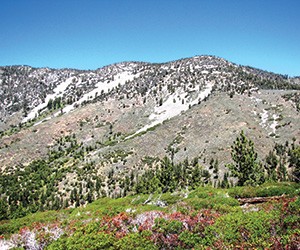Just as the city of Los Angeles is much more than Hollywood, the intersection of Riverside, San Bernardino and Los Angeles counties boasts a lot more than simply suburbs.
This densley populated area features several full-blown cities, major freeway intersections and an international airport. Throw in a world-class wine region and an alpine skiing playground and you’ve got an Inland Empire.
Ontario
Ontario is the Inland Empire’s business anchor thanks to Ontario International Airport, the intersection of four major freeways and big shipping and manufacturing operations. The city is continuing its recovery from the recession, says Bob Brown, president and CEO of the Ontario CVB.
“We’re getting new office towers built, there’s ground breaking, and downtown is being gentrified and revitalized with new parks,” he says.
Brown notes that the Ontario Convention Center is producing and hosting more shows, and developing new trade shows of its own.
Major meetings-friendly properties include the new Embassy Suites Ontario-Airport and three newly renovated properties: Ayres Hotel & Suites Ontario Convention Center, Doubletree by Hilton Ontario Airport and Radisson Ontario Airport.
Ontario Mills Shopping Center and Bass Pro Shops are popular attractions, along with Whispering Lakes Golf Course and pro hockey and arena football at Citizens Business Bank Arena.
San Bernardino
San Bernardino’s main tourism appeal will probably always be Route 66 nostalgia, says Wayne Austin, president and CEO of the San Bernardino CVB, but for groups nowadays, there’s another story—one centered on youth sports.
“We have the Western Regional Finals for Little League softball each July and baseball each August, so that has quite a bit of draw, especially with the ESPN2 coverage. And we’ve always had a leg up when it comes to soccer,” Austin says, noting the city’s 22-field soccer complex.
Route 66 and classic automobiles are remembered annually at Stater Brothers Route 66 Rendezvous, which attracts up to 500,000 people per day. The city also celebrates its history as Southern California’s premier railroad hub each April with Railroad Days, featuring both modern trains and a steam locomotive that runs to Los Angeles and back, as well as the San Bernardino History & Railroad Museum.
The California Theatre for the Performing Arts is popular for dramatic and musical productions, and along with the new 700-seat Sturges Theatre for the Performing Arts and a Regal Cinema complex opening in June, it anchors the city’s budding theater district.
San Bernardino’s meetings-friendly properties include the Hilton San Bernardino, Fairfield Inn & Suites by Marriott and Hilton Garden Inn San Bernardino.PageBreak
Riverside
Riverside is where California’s citrus industry got its start thanks to three Brazilian orange trees that the Department of Agriculture sent in 1873; just 22 years later, half of California’s citrus trees were growing here.
Today Riverside bills itself as the “City of Arts and Innovation,” an image supported by cultural facilities such as the Fox Performing Arts Center and architectural landmarks such as the Mission Inn National Historic Landmark Hotel & Spa, the Riverside County Courthouse and the Riverside Fox Theater.
The 40-acre botanical garden at University of California, Riverside contains four miles of walking trails, and California Citrus State Historic Park similarly celebrates plant life—the orange trees that inspired California’s “second Gold Rush.” Visitors may also tour March Field Air Museum, the Riverside Art Museum and the historic exhibits at the Riverside Metropolitan Museum.
While the Riverside Convention Center is closing for extensive remodeling until February 2014, it will retain some meetings capacity at the nearby Riverside Auditorium and Events Center. In addition, the Riverside Marriott and Mission Inn Hotel & Spa offer meeting space.
Claremont and Pomona
While Claremont has no convention center, its small-town atmosphere makes it a popular stop for Inland Empire visitors, says Maureen Aldridge, CEO of the Claremont Chamber of Commerce.
“We have a small-town feeling,” she says. “We have smaller stores and do fun things in the summer months. We have lots of parks, dinner theater and outdoor concerts in the summer months.”
Pomona is home to California State Polytechnic University, Pomona—Cal Poly Pomona, for short—as well as Fairplex, site of the annual Los Angeles County Fair. These venues make the city well-suited for meetings, especially considering the Kellogg West Conference Center and Hotel on the Cal Poly campus and the Sheraton Fairplex Hotel near the fairgrounds, which just opened a new conference center.
Mountain Resorts
The scenic mountain resort areas of Big Bear and Lake Arrowhead offer a cool, alpine break for smaller groups. The area is popular with church retreats, corporate groups, family reunions and military groups, says Dan McKernan, director of marketing and public relations at the Big Bear Lake Resort Association.
“Of course, there are plenty of natural visual aids from mountain vistas, lush meadows and pine-scented forests that help ignite creativity and production,” he says.
Seven-mile-long Lake Arrowhead is a big blue jewel that is popular for watersports, while skiing and hiking are available in the surrounding national forest and at Bear Mountain and Snow Summit resorts. Attendees can also ride Snow Summit’s Scenic Sky Chair to the View Haus restaurant for spectacular views.
Back at Big Bear Lake, jet boat tours are available for groups keen on speed, and pontoon boat rentals offer a more leisurely pace.
Major meetings-friendly hotel properties include Best Western Big Bear Chateau, Big Bear Resort & Spa, Grey Squirrel Resort, Lake Arrowhead Resort and Spa, and Saddleback Inn and Grill, while the premier meetings facilities are Big Bear Lake Convention Center and UCLA Lake Arrowhead Conference Center.PageBreak
Temecula
At the southern end of the Inland Empire is the Temecula Valley, which has completed its transformation from all-around agricultural hub to winegrowing area.
“Temecula” is a variation of the Native American word temeku, which translates as “where the sun shines through the mist.” This is excellent shorthand for the region’s climate, which enjoys both cool overnight ocean breezes and legendary Southern California sunshine. Since the 1980s, these features have combined to help wine grapes grow on a large scale, giving rise to today’s nearly three dozen area wineries.
Temecula proper has an old town with boutiques, antique dealers, museums, restaurants and in-town wine tastings at Tesoro Winery or Curry Vineyard’s tasting room at the Palomar Inn Hotel.
Top meetings properties include the Inn at Europa Village, Pechanga Resort & Casino, Ponte Vineyard Inn and South Coast Winery Resort & Spa.
Paul D. Kretkowski writes frequently about travel, food and sports. He is also the founder of Beacon, a blog about foreign policy.





